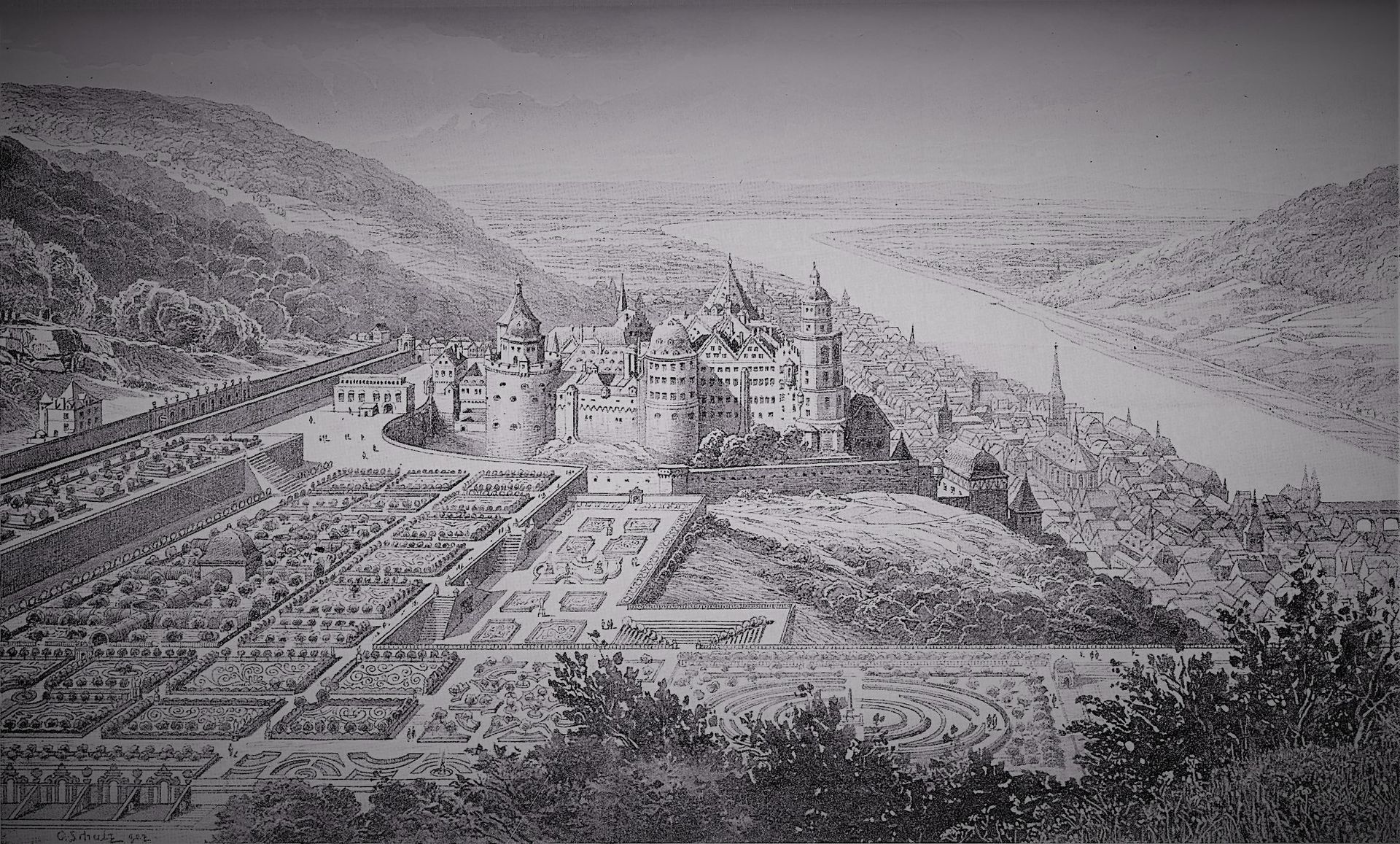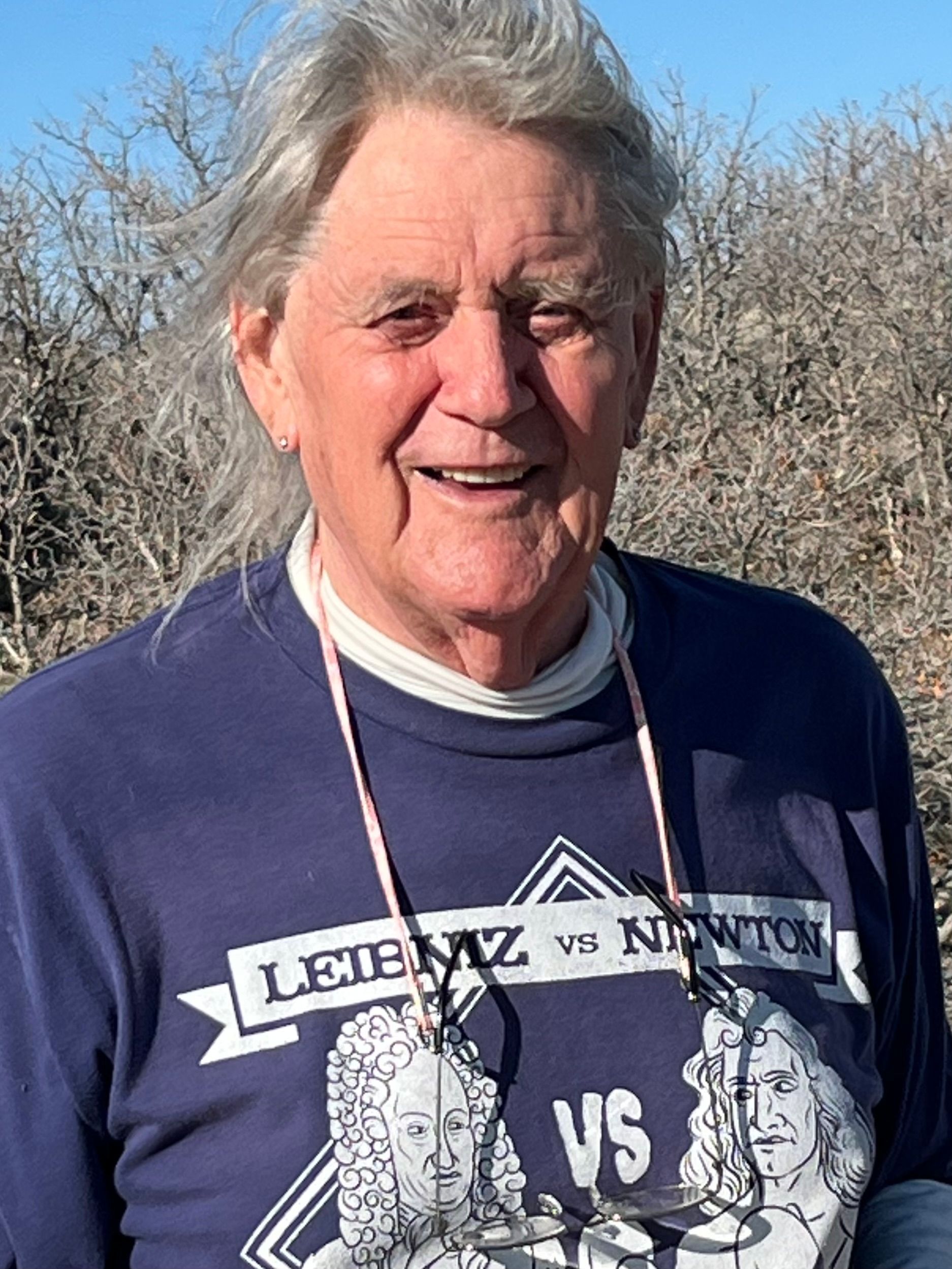Thursday's Columns
June 29, 2023

17th century view of Heidelberg Castle, looking west, down and out over the fertile lands of the historical Rhenish Palatinate, the Neckar flowing past the town towards the Rhine.
Our Story
by
Lawrence Abby Gauthier
ace reporter
The Westphalia Periodic News

Our ace reporter on assignment in Europe
Americans in Europe (Part 3)
So we got hopelessly lost in the geometrical paths of roads first laid out during the Roman Empire before there were cars, and we never did make it to Westphalia. But that was ok. My intellectual roots were all over Germany.
At the outdoor café on the outskirts of Mannheim I ordered a German beer to wash down the taste of Octopus and I knew where my love of beer came from.
It was still early afternoon. Cloudless. But not too hot. If we could find our way back to Heidelberg, I would still have time to visit and take in the lingering past of the medieval castle there – Heidelberg Castle, where an incredible story first began.
During the past several years back in America I’d been writing a novel about economics. It’s taking me forever because I don’t know how to write a book and I haven’t taken the time to learn the language of economics. The process has taken me down the path of many stories rooted in the distant past, but the roots of the story I wanted to tell kept bringing me back to Germany. There have been Wikipedic journeys to other parts of the world, France and especially England, even China. But I kept winding up in Germany. And here I was, in the historical Rhenish Palatinate, just a few tightly wound miles from Heidelberg where the story begins when a girl who was River’s age - 16 – first enters the castle overlooking the town.
It’s the story of a path not taken, a magic ring not grasped, a veil not caught. It’s a tragic story, really, because we came so close.
It’s the story of a liberating idea that was suppressed for the personal reasons of a few who’d been born and raised to rule the world.
It’s the story of science beginning with two seemingly parallel lines of thought – physics and metaphysics.
For thousands of years everybody said parallel lines can never touch because the experts said so and that’s the way it looked so that was the way it was. But in the 17th century, in Germany, a brilliant thinker sparked a continent-wide debate when he argued, and created a mathematics to prove, that there was another way of looking at it.
The great debate is preserved in dusty volumes of pages of the correspondence passed amongst the learned circles of the day. The debate was the subject of heated late night discussions at the École Polytechnique in Paris, where the world’s greatest mathematicians, philosophers and scientists were gathered at the time.
Modern commentators refer to the great 17th century debate as the “Newton-Leibniz Controversy.”
Isaac Newton (1642-1726) said it all comes down to tiniest particles separated by empty space.
Gottfried Wilhelm Leibniz (1646–1716) said there’s no such thing as empty space.
Newton’s universe was a rack of billiard balls scattered into motion by the hand of a Supreme Being at a particular point in time. Newton’s balls were called atoms, from a Greek word for “can’t be cut.” Without parts, they are the deadest things imaginable. Gradually losing their energy of momentum into empty space through countless collisions over measurable periods of time, the balls inevitably stop moving around on the table. They come to a stop. The end of motion. Entropic death. Unless a Supreme Being produces another miracle, it’s all over, for all of the rest of time.
Leibniz, however, by starting from the idea that there’s no such thing as empty space, saw things in a completely different way.
Instead of winding down, his universe was ever winding up, ever striving towards greater perfection. Entropic collapse was a fantasy because it violated the first principle of Nature… that there’s no such thing as empty space. When people looked to the sky at night, it looked like empty space between the stars. But Leibniz argued that appearances can be deceiving. He said time itself and space were not the way they looked, preparing the way for Einstein centuries later. He said energy was infinite. He said there was enough for everybody and that everybody deserved to have enough. He said lots of things like that. Despite the observable evidence of wars, plague, hunger and natural disasters, he said we live in the best of all possible worlds and that it would keep getting better because that was the nature of reality… ever striving towards greater perfection without a beginning or an end because time was not the way it appeared to be.
He introduced the Idea of Progress, wrapping it in the clothing of science.
He fathered the Philosophy of Optimism.
The followers of Newton said Leibniz was a crackpot. If there was no empty space the entire universe would be one big dead ball.
Newton became mainstream.
Leibniz fell into obscurity, relegated to the dustbins of history with a long list of other crackpots, wizards and metaphysicians.
To this day, everybody has heard of Newton. Everybody knows he “discovered” what everybody already knew – that things fall. Just like the stories about Washington’s cherry tree, Franklin’s kite and Lincoln’s logs, everybody knows the story about the apple falling on Newton’s head. Eve bit of it when humanity chose to go it alone. The story could still have a happy ending, so to speak. There's still time.
But while Newton went on to become a household name throughout the world, Leibniz would remain virtually unknown to the wider public. A few, maybe, in a high school calculus class would learn, maybe, that mathematicians have long debated who invented calculus – Newton or Leibniz? Maybe in a college French class they’d been required to read Voltaire’s Candide, where Leibniz is mocked and dismissed as a lunatic. Beyond that, hardly anybody today, in America, at least, has ever heard of him. You could go to a baseball game and ask 40,000 fans who Leibniz was and get 39,987 blank stares.
Now that was the story that interested me, the one I wanted to tell. How come hardly anybody in the stands had ever even heard of Leibniz? Like we go to the moon and a few generations later nobody knows about it except for a few at the top and they want to keep it secret so the people don’t know what we’re capable of and start asking for too much.
How could the people not know?
My old newspaper instincts kicked in.
The story had the scent of something that might get me a Pulitzer Prize, maybe a spot on the Johnny Carson Show.
And it began at Heidelberg Castle.
We headed in that direction and along the way got gas, which, in Europe, is more complicated than it is in Colorado.
River went inside the gas station to get some snacks and then came running back out to the car all excited. She said I had to see something inside. I followed her inside. And then I took a picture of it.

"Look what I found," River said.
